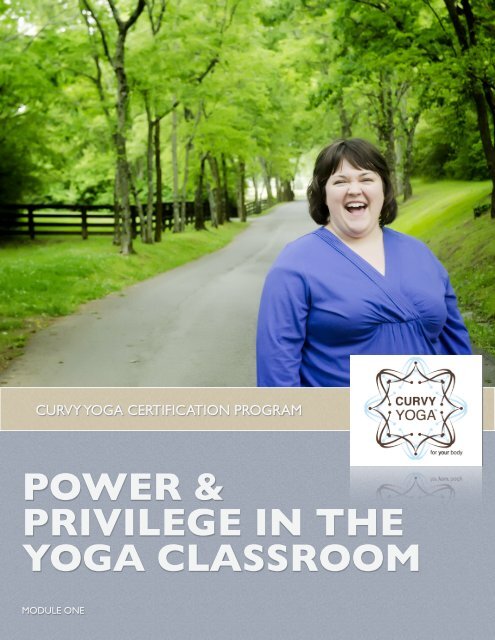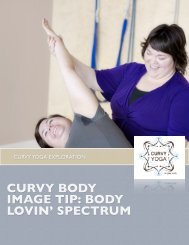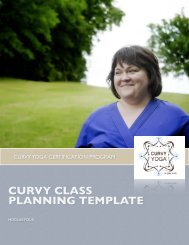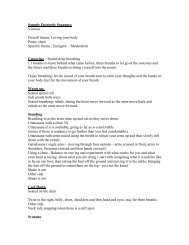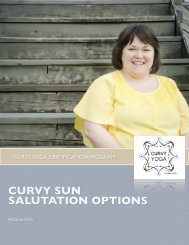POWER & PRIVILEGE IN THE YOGA CLASSROOM - Curvy Yoga
POWER & PRIVILEGE IN THE YOGA CLASSROOM - Curvy Yoga
POWER & PRIVILEGE IN THE YOGA CLASSROOM - Curvy Yoga
You also want an ePaper? Increase the reach of your titles
YUMPU automatically turns print PDFs into web optimized ePapers that Google loves.
CURVY <strong>YOGA</strong> CERTIFICATION PROGRAM<br />
<strong>POWER</strong> &<br />
<strong>PRIVILEGE</strong> <strong>IN</strong> <strong>THE</strong><br />
<strong>YOGA</strong> <strong>CLASSROOM</strong><br />
MODULE ONE
Power and Privilege in the <strong>Yoga</strong><br />
Classroom<br />
!<br />
!<br />
Two things that show up in every yoga classroom in varying ways are power and privilege. Awareness of<br />
how they show up contributes to a safe environment for your students.<br />
Power<br />
When we think about who has power, we typically mean that in a power over kind of way. In other words,<br />
a situation where one person (or a group of people) has power over another person (or group of people). 1<br />
Power typically accrues to those who most closely approximate the mythical norm. In yoga in the US, the<br />
mythical norm is a white, able-bodied, thin, youngish, middle-to-upper class woman.<br />
If you’re wondering who has power in a given situation/class/institution, consider the following questions<br />
from Paul Kivel 2 :<br />
• Who is in authority?<br />
• Who has credibility (whose words and ideas are listened to with most attention and respect)?<br />
• Who is treated with full respect?<br />
• Whose voices are heard?<br />
• Who has access to or is given important information?<br />
• Who talks most?<br />
• Whose ideas are given most importance?<br />
• Who is assigned or expected to take on background roles?<br />
• How is the space designed? Who has physical access?<br />
• What is on the walls?<br />
© <strong>Curvy</strong> <strong>Yoga</strong> www.<strong>Curvy</strong><strong>Yoga</strong>.com 1
!<br />
• What language(s) are used? Which are acceptable?<br />
!<br />
• Who decides?<br />
Privilege<br />
Privilege is an invisible package of unearned assets 3 . Until we develop awareness of our privilege, it is<br />
generally something that we are blind to and/or perceive as the norm.<br />
For example, in Peggy McIntosh’s “White Privilege: Unpacking the Invisible Knapsack” (included in your<br />
binder), she gives examples of white privilege that include:<br />
• I can turn on the television or open to the front page of the paper and see people of my race<br />
widely represented.<br />
• I am never asked to speak for all people of my racial group<br />
• If a traffic cop pulls me over, or if the IRS audits my tax return, I can be sure I haven’t been singled<br />
out because of my race<br />
Why This Matters<br />
In the yoga classroom, unexamined power and privilege can lead to students ignoring what is best for their<br />
own body and self, possibly leading to injury.<br />
And in the worst-case scenarios, it leads to large-scale abuse of power, as we’ve seen recently in the yoga<br />
community with John Friend (Anusara <strong>Yoga</strong>), Kausthub Desikachar and Bikram Choudhury (Bikram <strong>Yoga</strong>) 4 .<br />
Power With<br />
Fortunately, there are other options than “power over.” Power with is collaborative and relational. Rather<br />
than one person having power over another, power with empowers a group to create consensus together.<br />
Examples:<br />
© <strong>Curvy</strong> <strong>Yoga</strong> www.<strong>Curvy</strong><strong>Yoga</strong>.com 2
!<br />
!<br />
• Power Over: In a typical weekly yoga class, power over might show up as: not talking with students<br />
before class, starting or ending class late, giving physical adjustments without consent, and only<br />
teaching the least supported version of the pose.<br />
• Power With: In a typical weekly yoga class, power with might show up as: asking students open<br />
ended questions before class, starting/ending class on time, offering physical adjustments only with<br />
enthusiastic consent, and teaching many different pose options, starting with the most supported.<br />
My Privilege<br />
To encourage you to consider your own privilege, I am sharing mine (in what is a surely incomplete list)<br />
• I’m white<br />
• I’m heterosexual<br />
• I grew up middle class & still am middle class<br />
• I can pass as any religion or political persuasion: most people assume I agree with whatever their<br />
beliefs are<br />
• I not only have a college education, I have two master’s degrees<br />
• Although I’m fat, I’m able-bodied<br />
• I have the resources to continue my yoga teacher education and have completed 500+ hours of<br />
training<br />
What’s yours, and how does it affect your teaching?<br />
References<br />
1. http://www.thepowerofcollectivewisdom.com/pdfs/power-over.pdf<br />
2. http://www.paulkivel.com/resources/articles/23-article/95-the-culture-of-power<br />
3. http://ted.coe.wayne.edu/ele3600/mcintosh.html<br />
4. http://yogadork.com/news/bikram-choudhury-accused-of-rape-in-two-new-lawsuits/<br />
© <strong>Curvy</strong> <strong>Yoga</strong> www.<strong>Curvy</strong><strong>Yoga</strong>.com 3


